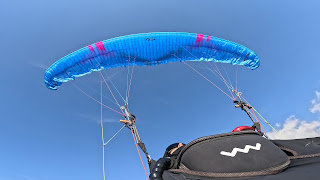NIVIUK PEAK 6 22
Having flown practically all Peaks! 1-2-3-4-5, and Icepeak 6, here’s the 6th version with 7 aspect ratio.
The leading edge holds a moderate shark nose, and as usual, the construction, to the smallest details is excellent on this Peak 6.
I flew the Peak 6 at 94 and 97. I think around 95..96 is an optimum weight in all conditions for glider reactions through the airmass. If you want a more faster glider through the air, 98…99 could be great.
Launching the Peak 6 is very straightforward, without any delay. The rise is homogenous, and moderate without any hard points. No shooting forward with little brake control, and even with windy take off the pilot has the authority of control. Overall very easy launch for that 7 aspect ratio 2 liner D.
In the air, the biggest difference between the Peak 5 and the Peak 6 is the shorter, more responsive brake travel even in turbulent air. The Peak 6 has a moderate to slightly hard brake pressure than the Peak 5 and the Artik-R. The authority on the brakes in turbulent conditions is very good under the Peak6 giving the pilot complete control. Smooth turns can be made with good agility for that class. It could be as quick to turn as the Artik-R if you open the chest strap to 50 cm on the Arrow harness. This authority of the brakes gives the pilot swift control for any movements under the Peak 6.
Immediately after taking off, I could feel the high comfort under the Peak 6! This glider has perhaps the double comfort found on the Peak 5! And more comfortable to fly than the Zeno1-2, Magus XC, Peak 3, Peak5, and Icepeak 6. I think the Peak 6 has the DNA of the Peak 4 and matches its comfort with an even more solid, homogenous structure. When flying it in strong air I felt that this whole structure didn’t lose its homogeneity and was kept as a block above my head. Even if the Artik-R stretches a bit and wobbles in heavy air, the Peak 6 felt more coherent! Of course, the pilot level is another step from the Artik-R but just to precise that solid feel.
The roll movements are also much more dampened than the Peak 5, Zeno2, and resembles surprisingly the Peak 4 ones. I found out that flying it with the Arrow enhanced the turning ability, and the roll is very controllable.
The Peak 6 pitch behavior is also neutral. It doesn’t shoot forward in moderate thermals. Just perhaps it slows and sometimes bumps a bit before entry, but still enters slowly the climb and moves upward. I found that the best way to dig through is at first to load it at the top (98) and to trust it, by releasing the brakes as much as it would be possible. That will help a faster entry. I also noticed that flying it at the very top end 98 will help reduce the bump feel. Overall, the Peak 6 is a really comfortable glider to fly for a 7 aspect ratio 2 liner in the D class.
Loading it at 98 will get this structure to be even more indestructible, and it could be a nice tool for achieving local competitions or getting the most in your strong XC days.
In weak conditions, even at 96 all up, I felt that the Peak 6 climb well, and I could squeeze it in a very narrow small core. Opening the chest strap at 50 cm on the Arrow harness helped a lot by making it very agile in turns.
The glide at trim and accelerated is excellent, for the category, with a very taught leading edge even at full bar. I could get 18-19 km/h over trim. The B controls are quite a big step in usability over the Peak 5! I could control the glider with a moderate pull, while on bar. The pressure on the B steering is moderate and very usable. Forget about the Peak 5 controls and feel…The Peak 6 is a completely changed glider.
I flew next to a Zeno 2 the same size and loaded in windy and strong turbulent air. While the racing genes of the Zeno 2 felt more dynamic and surged through the air more aggressively going forward, especially on windy days, the Peak 6 while having a very close glide, and climb, is aimed more toward a calmer efficient cross-country use. It surfs the air calmly and moves forward with slower reactions.
In normal conditions, without too much wind, the Peak 6 feels and handles like a slightly lower-rated glider, but with D-class performance. For pilots aiming for 100 % cross-country use, the Peak 6 will deliver with less energy management.
Stepping on the bar on long, lift lines while B steering felt easy and controllable with a very good glide angle. The pressure on the B controls are moderate with swift input. Ears with outer A’s are stable and reopen with pilot assistance. Ears with Outer B’s are also doable, easy, stable, and reopen quickly. Getting wing over on the Peak 6 lets you feel that energy! After two turns they became really high. The exit is easy as the 360 ones. The Peak 6 felt very homogenous.
Conclusion:
After test flying the Peak 6, I think NIVIUK wanted to revive the Peak 4 success by creating a comfortable, easy, confidence-inspiring, EN-D 2 liner. I think pilots upgrading from the Artik 6 with 2 full seasons in strong air, could be a logical move toward an easy, but much more performant EN-D glider.




































